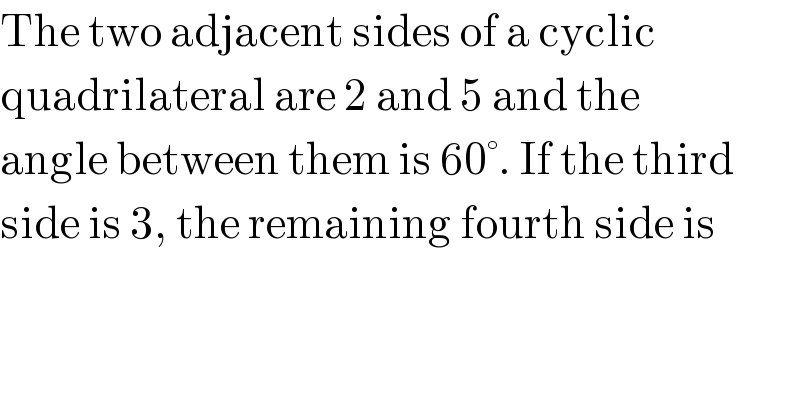Question Number 113847 by deepraj123 last updated on 15/Sep/20

$$\mathrm{The}\:\mathrm{two}\:\mathrm{adjacent}\:\mathrm{sides}\:\mathrm{of}\:\mathrm{a}\:\mathrm{cyclic} \\ $$$$\mathrm{quadrilateral}\:\mathrm{are}\:\mathrm{2}\:\mathrm{and}\:\mathrm{5}\:\mathrm{and}\:\mathrm{the} \\ $$$$\mathrm{angle}\:\mathrm{between}\:\mathrm{them}\:\mathrm{is}\:\mathrm{60}°.\:\mathrm{If}\:\mathrm{the}\:\mathrm{third} \\ $$$$\mathrm{side}\:\mathrm{is}\:\mathrm{3},\:\mathrm{the}\:\mathrm{remaining}\:\mathrm{fourth}\:\mathrm{side}\:\mathrm{is} \\ $$
Answered by 1549442205PVT last updated on 16/Sep/20

Commented by 1549442205PVT last updated on 16/Sep/20

$$\left.\mathrm{i}\right)\mathrm{Case}\:\mathrm{CD}=\mathrm{3} \\ $$$$\mathrm{From}\:\mathrm{the}\:\mathrm{hypothesis}\: \\ $$$$\mathrm{AB}=\mathrm{2},\mathrm{BC}=\mathrm{5},\widehat {\mathrm{ABC}}=\mathrm{60}°,\mathrm{CD}=\mathrm{3}\:\mathrm{and} \\ $$$$\mathrm{cosine}\:\mathrm{theorem}\:\mathrm{we}\:\mathrm{have} \\ $$$$\mathrm{AC}^{\mathrm{2}} =\mathrm{AB}^{\mathrm{2}} +\mathrm{BC}^{\mathrm{2}} −\mathrm{2AB}.\mathrm{BC}.\mathrm{cos60}° \\ $$$$\Leftrightarrow\mathrm{AC}^{\mathrm{2}} =\mathrm{2}^{\mathrm{2}} +\mathrm{5}^{\mathrm{2}} −\mathrm{2}.\mathrm{2}.\mathrm{5}.\frac{\mathrm{1}}{\mathrm{2}}=\mathrm{19}.\mathrm{On}\:\mathrm{the} \\ $$$$\mathrm{other}\:\mathrm{hand},\widehat {\mathrm{ADC}}=\mathrm{180}°−\widehat {\mathrm{ABC}}=\mathrm{120}° \\ $$$$\left(\mathrm{since}\:\mathrm{quadrilateral}\:\mathrm{ABCD}\:\mathrm{inscribed}\right) \\ $$$$\mathrm{Apply}\:\mathrm{cosine}\:\mathrm{theorem}\:\mathrm{for}\:\Delta\mathrm{ACD}\:\mathrm{with} \\ $$$$\mathrm{AC}=\sqrt{\mathrm{19}},\mathrm{AD}=\mathrm{3},\widehat {\mathrm{ADC}}=\mathrm{120}°\mathrm{we}\:\mathrm{get} \\ $$$$\mathrm{AC}^{\mathrm{2}} =\mathrm{CD}^{\mathrm{2}} +\mathrm{AD}^{\mathrm{2}} −\mathrm{2AD}.\mathrm{CDcos120}° \\ $$$$\Leftrightarrow\mathrm{19}=\mathrm{3}^{\mathrm{2}} +\mathrm{AD}^{\mathrm{2}} −\mathrm{2}.\mathrm{3}.\mathrm{AD}.\left(−\frac{\mathrm{1}}{\mathrm{2}}\right) \\ $$$$\Leftrightarrow\mathrm{AD}^{\mathrm{2}} +\mathrm{3AD}−\mathrm{10}=\mathrm{0}.\mathrm{Solve}\:\mathrm{this}\:\mathrm{equation} \\ $$$$\Delta=\mathrm{9}+\mathrm{4}.\mathrm{10}=\mathrm{7}^{\mathrm{2}} \Rightarrow\mathrm{AD}=\left(−\mathrm{3}+\mathrm{7}\right)/\mathrm{2}=\mathrm{2} \\ $$$$\mathrm{Thus},\mathrm{fourth}\:\mathrm{side}\:\mathrm{equal}\:\mathrm{to}\:\mathrm{2}\left(\mathrm{cm}\right) \\ $$$$\left.\mathrm{ii}\right)\mathrm{Case}\:\mathrm{AD}=\mathrm{3}\:\mathrm{we}\:\mathrm{do}\:\mathrm{similarly}\:\mathrm{also} \\ $$$$\mathrm{getting}\:\mathrm{CD}=\mathrm{2} \\ $$
